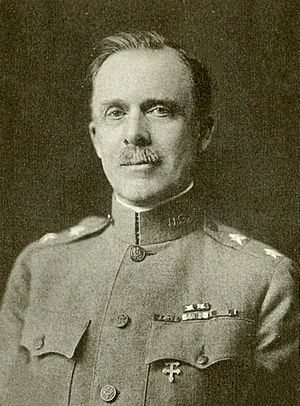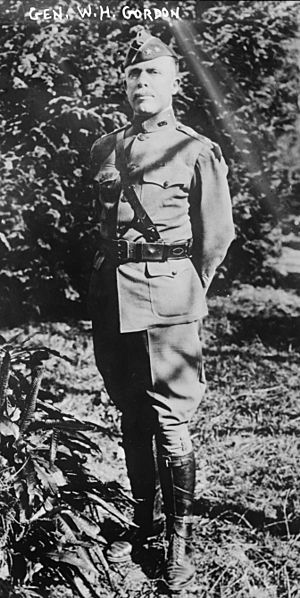Walter Henry Gordon facts for kids
Quick facts for kids
Walter Henry Gordon
|
|
|---|---|

Major general Walter H. Gordon, U.S.A.
|
|
| Born | June 24, 1863 Artonish, Mississippi |
| Died | April 26, 1924 (aged 60) Washington, D.C. |
| Buried | |
| Allegiance | |
| Service/ |
|
| Years of service | 1886–1924 |
| Rank | |
| Unit | |
| Commands held | Army Infantry School Fourth Corps Area 82nd Infantry Division 6th Infantry Division 21st Infantry Regiment 15th Infantry Regiment 31st Infantry Regiment |
| Battles/wars | Indian Wars Philippine–American War World War I
|
| Awards | Distinguished Service Medal Legion of Honour Croix de Guerre |
Walter Henry Gordon (June 24, 1863 – April 26, 1924) was a brave and highly respected officer in the United States Army. He reached the high rank of Major General. He fought in the Philippine–American War and is best known for leading the 6th Infantry Division during a major battle called the Meuse-Argonne Offensive in 1918, which was a very important part of World War I.
After World War I, General Gordon continued to serve his country. He commanded the United States Army Infantry School at Fort Benning and also led the Fourth Corps Area. He retired from the Army in January 1924 and passed away a few months later.
Contents
Early Life and Military Training
Walter H. Gordon was born on June 24, 1863, in Artonish, Mississippi. His parents were William Crawford and Mary (Lewis) Gordon. After finishing high school, Walter was accepted into the United States Army War College at West Point, New York. This is a famous military academy where future leaders are trained.
He worked hard and graduated with a Bachelor of Science degree on July 1, 1886. After graduating, he became a second lieutenant in the Infantry branch, which means he was a leader of foot soldiers. Many of his classmates at West Point also became important generals later on, including John J. Pershing, who led American forces in World War I.
First Assignments and Frontier Duty
After West Point, Gordon was sent to Madison Barracks in Sackets Harbor, New York. He joined the 12th Infantry Regiment there. In July 1887, his regiment moved to Fort Yates, North Dakota. Here, he served on the frontier during the Indian Wars, which were conflicts between the U.S. Army and Native American tribes.
In November 1890, he went to Willet's Point to attend the Torpedo School. This training helped him learn about military explosives and defenses.
Promotions and Teaching Roles
Gordon was promoted to first lieutenant in November 1892. He then joined the 18th Infantry Regiment at Fort Leavenworth, Kansas. He also had a temporary job in Chicago in 1893 during the World's Columbian Exposition, a big world fair.
Later, he was stationed at Fort Bliss, Texas. From there, he became a Professor of Military Science and Tactics at the Louisiana State University in Baton Rouge, Louisiana. This meant he taught military skills and leadership to college students. After a year, he rejoined his regiment in Texas. He then took on another teaching role at Delaware College in Newark, Delaware.
Service in the Spanish-American and Philippine-American Wars
In April 1898, the United States went to war with Spain, known as the Spanish–American War. Gordon was temporarily promoted to Major in the Volunteers. He helped gather and train soldiers in Middletown, Delaware. He served with the 1st Delaware Volunteer Infantry and was even promoted to the temporary rank of Colonel of the Volunteers in September 1898.
After the war with Spain ended, Gordon returned to his regular Army rank of first lieutenant. In January 1899, he went to the Philippines for duty. While he was traveling, the Philippine–American War began. He was promoted to captain on March 2, 1899. He fought against Filipino fighters on the Island of Panay until September 1901. He led his company and a group of mounted scouts.
After his time in the Philippines, he returned to the U.S. and was stationed at Fort D. A. Russell in Wyoming. He also took part in military exercises at Fort Riley. He went back to the Philippines in March 1903 and served in a leadership role during the Moro Rebellion, another conflict.
Gordon returned to the U.S. in February 1905. He was stationed at Fort Leavenworth and participated in more military exercises. He went to the Philippines for a third time in November 1907. He worked in military intelligence, gathering important information for the Army. In March 1909, he was promoted to major.
Later Assignments Before World War I
After a period of illness, Gordon joined the Office of the Inspector General of the Army. This office checks to make sure the Army is following rules and doing things correctly. He then became an Inspector-General for the Department of Dakota in Saint Paul, Minnesota.
In 1913, Gordon attended the United States Army War College, a school for senior military officers. He finished in June 1914 and was promoted to lieutenant colonel in September 1914. He took command of the 3rd Infantry Regiment and led them in training exercises.
In November 1915, he was sent to the Philippines again. He commanded the 31st Infantry Regiment until June 1917. He then traveled to China and took command of the 15th Infantry Regiment in Tianjin.
As the United States entered World War I, Gordon was promoted to the temporary rank of brigadier-general on August 5, 1917. He was briefly in charge of the U.S. military forces in China before being called back to the United States.
World War I Service
When General Gordon returned to the U.S., he was put in charge of the Depot Brigade at Camp Meade, Maryland. His job was to train soldiers who were getting ready to go fight in France. In January 1918, he was assigned to the new 5th Infantry Division in Houston, Texas, where he commanded the 10th Infantry Brigade.
In May 1918, Gordon and his brigade arrived in France. They went through intense training to prepare for combat. In June, his brigade was sent to the Vosges front, a battle area, where they fought alongside French divisions.
Leading the 6th Infantry Division
Gordon led his brigade during the Frapelle engagement in August 1918. For his excellent service, he was promoted to the temporary rank of Major General. He then took command of the 6th Infantry Division. He led this division in battles in the Geradmer sector from September to October 1918.
General Gordon then commanded the 6th Division during the very important Meuse-Argonne Offensive. This was one of the largest and deadliest battles in American history. His division fought bravely in areas like Beauchamp Farm, Artaise, Stonne, and the Argonne Forest.
After the war ended with the Armistice (a ceasefire) in November 1918, the 6th Division first went to a training area. Then, they became part of the occupation of the Rhineland in Germany, helping to keep peace until April 1919.
For his outstanding leadership and bravery during World War I, General Gordon received several important awards:
- The Army Distinguished Service Medal from the United States.
- The Legion of Honour from the French government.
- The Croix de Guerre with Palm from the French government.
After the War
General Gordon returned to the United States with the 6th Infantry Division in June 1919. He went back to his peacetime rank of colonel. He then commanded the 21st Infantry Regiment near Spokane, Washington. In October 1919, he moved to Washington, D.C. to work in the Office of Inspector General of the Army.
He was promoted to Brigadier General again on July 3, 1920. He became the Commandant (leader) of the United States Army Infantry School at Fort Benning, Georgia. He also took on extra duties, commanding the Fourth Corps Area and the 82nd Infantry Division. This meant he held three important commands at the same time!
Gordon was promoted to the rank of Major General on November 7, 1923. He then worked with a special board of officers at the War Department General Staff in Washington, D.C. He also served as a temporary Deputy Chief of Staff.
Due to health problems, General Gordon asked to retire on January 18, 1924, after serving his country for 38 years.
Major General Walter H. Gordon passed away suddenly on April 26, 1924, at the age of 60, in Washington, D.C.. He was buried with full military honors at Arlington National Cemetery in Virginia. He was survived by his wife, Laura Doan Gordon.
Awards and Medals
Here are the awards and medals that Major General Gordon received for his service:
| 1st Row | Army Distinguished Service Medal | |||||||||||||
|---|---|---|---|---|---|---|---|---|---|---|---|---|---|---|
| 2nd Row | Indian Campaign Medal | Philippine Campaign Medal | World War I Victory Medal with two Battle Clasps | |||||||||||
| 3rd Row | Army of Occupation of Germany Medal (Awarded after his death) | Legion of Honour, rank Officer (France) | French Croix de guerre 1914–1918 with Palm (France) | |||||||||||


